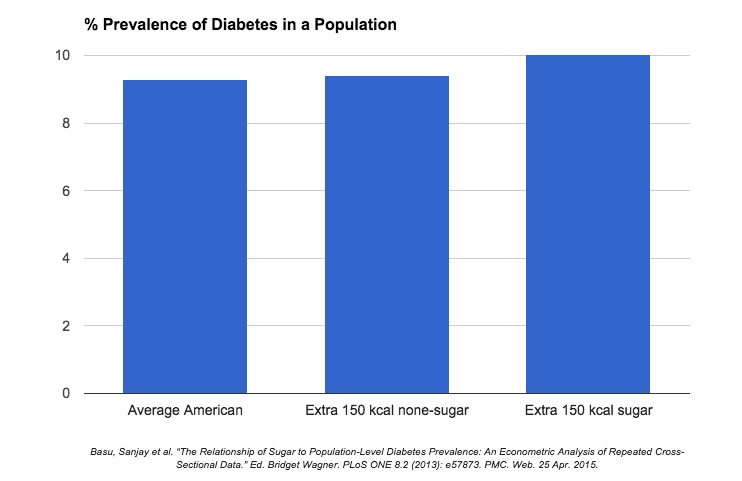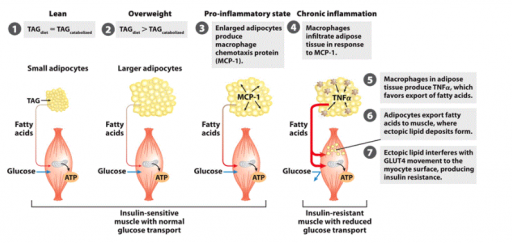A recent article in the British Journal of Sports Medicine^ is being widely reported, with varying degrees of accuracy. One piece of data in the article in particular seems to suggest that if you consume an extra 150 calories of sugar daily (e.g. one extra can of soda) then you get an 11-fold increase in your risk of type two diabetes:
http://www.ncbi.nlm.nih.gov/pmc/articles/PMC3584048/ (http://archive.is/wGmbO)
Which says:
Or put another way, people who consuming an extra 150 calories of sugar will, on average, have a 10.4% incidence of diabetes, compared to 9.4% for people who consume an extra 150 calories of fat or protein, or 9.3% for people who don't have that extra 150 calories. Or:

Unfortunately this is not at all clear in the numerous retellings of the story, and nor is it clear that they are talking about daily calories:
http://www.bbc.com/news/health-32417699 (http://archive.is/UXzGA)
http://forum.bodybuilding.com/showthread.php?t=167257011 (http://archive.is/8OTTX)
http://www.medicaldaily.com/overeat...ot-inactivity-you-cant-outrun-bad-diet-330342 (http://archive.is/mGd7k)
And when reduced to a Tweet, the misrepresentation is obviously going to get repeated as fact:
Others are simply confusing:
http://www.mnn.com/health/fitness-well-being/blogs/you-cant-outrun-a-bad-diet-study-finds (http://archive.is/qQR96)
These various levels of inaccurate retelling are indicative of a common problem in web journalism. Many sites simply re-tell a story obtained from another source. This in turn may well be retold. And as the writers re-word things to avoid the appearance of plagiarism, they gradually introduce errors, particularly if they do not understand the topic, or the math.
Here the original data is actually in the rather dusty study: "The relationship of sugar to population-level diabetes prevalence: an econometric analysis of repeated cross-sectional data" - so far back down the food chain of article retelling that nobody is likely to check it. At most they might go back to the BJSM article, with the rather misleading "11-fold" description, and not realize they are talking about a difference between an increase of 0.1% and 1.1%, and so they don't clarify.
Then somebody writes and article based on their article, and the error becomes assumed fact.
One of the best attempts at clarifying this was from someone who clearly understood what the numbers meant, and did a better job than the BJSM, but still unfortunately fell short:
http://www.huffingtonpost.com/robert-lustig-md/sugar-toxic_b_2759564.html (http://archive.is/bYiRh)
And really using a multiple is rather meaningless, as what we are talking about is a difference in multiples. 10.4% and 9.4% vs. 9.3%. If the non sugar figure was just slightly different at 9.3%, then instead of 0.1% vs. 1.1% giving "11-fold", you'd have 0.0% vs. 1.1%, and so to be consistent you would have to say "for every excess 150 calories of sugar (say, one can of cola), there was a infinite increase in the prevalence of type 2 diabetes"
However this is not correct, the article gives the source of this claim:A large econometric analysis of worldwide sugar availability, revealed that for every excess 150 calories of sugar (say, one can of cola), there was an 11-fold increase in the prevalence of type 2 diabetes, in comparison to an identical 150 calories obtained from fat or protein.
http://www.ncbi.nlm.nih.gov/pmc/articles/PMC3584048/ (http://archive.is/wGmbO)
Which says:
The problem where is that what the BJSM article is describing as an increase in the prevalence of diabetes is actually an increase in the increase in the prevalence of diabetes. The key being that it's compared to "an identical 150 calories obtained from fat or protein." which increases the prevalence by 0.1%, and since 1.1% is 11x 0.1%, then that's an "11-fold increase".every 150 kcal/person/day increase in sugar availability (about one can of soda/day) was associated with increased diabetes prevalence by 1.1%
Or put another way, people who consuming an extra 150 calories of sugar will, on average, have a 10.4% incidence of diabetes, compared to 9.4% for people who consume an extra 150 calories of fat or protein, or 9.3% for people who don't have that extra 150 calories. Or:

Unfortunately this is not at all clear in the numerous retellings of the story, and nor is it clear that they are talking about daily calories:
http://www.bbc.com/news/health-32417699 (http://archive.is/UXzGA)
Which leads to responses like:research has shown that diabetes increases 11-fold for every 150 additional sugar calories consumed compared to fat calories.
http://forum.bodybuilding.com/showthread.php?t=167257011 (http://archive.is/8OTTX)
The more the retelling strays from the original text, the more significant the error becomes:research has shown that diabetes increases 11-fold for every 150 additional sugar calories consumed compared to fat calories." - So apparently a mars bar a day amidst a healthy diet will pretty much increase my risk of diabetes 11 fold! I wonder if this adds up, for every mars bar i've eaten its stacked 11 more times. I must have diabetes about 3000 times by now.
http://www.medicaldaily.com/overeat...ot-inactivity-you-cant-outrun-bad-diet-330342 (http://archive.is/mGd7k)
http://cdanews.com/2015/04/the-root...d-to-carbohydrate-consumption-not-inactivity/ (http://archive.is/1dxKK)The research team crunched the numbers and found for every 150 extra calories you consume from sugar, your diabetes risk increases by 11 times.
Here they don't even note this is compared to other sources of calories. At this point it can't really be considered to be simply unclear, these statements are flat wrong.Researchers determined that a person increases their risk of developing type 2 diabetes by 11 times for every 150 extra calories they consume from carbohydrates, specifically sugar.
And when reduced to a Tweet, the misrepresentation is obviously going to get repeated as fact:
Others are simply confusing:
http://www.mnn.com/health/fitness-well-being/blogs/you-cant-outrun-a-bad-diet-study-finds (http://archive.is/qQR96)
"11 times more likely to increase risk" is meaningless, unless you know how much it increases the risk.For example, drinking one 150-calorie soda is 11 times more likely to increase a person's risk for type 2 diabetes, compared to 150 calories obtained from fat or protein.
These various levels of inaccurate retelling are indicative of a common problem in web journalism. Many sites simply re-tell a story obtained from another source. This in turn may well be retold. And as the writers re-word things to avoid the appearance of plagiarism, they gradually introduce errors, particularly if they do not understand the topic, or the math.
Here the original data is actually in the rather dusty study: "The relationship of sugar to population-level diabetes prevalence: an econometric analysis of repeated cross-sectional data" - so far back down the food chain of article retelling that nobody is likely to check it. At most they might go back to the BJSM article, with the rather misleading "11-fold" description, and not realize they are talking about a difference between an increase of 0.1% and 1.1%, and so they don't clarify.
Then somebody writes and article based on their article, and the error becomes assumed fact.
One of the best attempts at clarifying this was from someone who clearly understood what the numbers meant, and did a better job than the BJSM, but still unfortunately fell short:
http://www.huffingtonpost.com/robert-lustig-md/sugar-toxic_b_2759564.html (http://archive.is/bYiRh)
This is still not clear, as you still have "diabetes prevalence rose 11-fold", and it should have been "the increase in diabetes prevalence rose 11-fold".Total caloric availability was unrelated to diabetes prevalence; for every extra 150 calories per day, diabetes prevalence rose by only 0.1 percent. But if those 150 calories per day happened to be a can of soda, diabetes prevalence rose 11-fold, by 1.1 percent (and Americans on average consume the added sugar equivalent of 2.5 cans of soda^p er day, so that's 2.75 percent!).
And really using a multiple is rather meaningless, as what we are talking about is a difference in multiples. 10.4% and 9.4% vs. 9.3%. If the non sugar figure was just slightly different at 9.3%, then instead of 0.1% vs. 1.1% giving "11-fold", you'd have 0.0% vs. 1.1%, and so to be consistent you would have to say "for every excess 150 calories of sugar (say, one can of cola), there was a infinite increase in the prevalence of type 2 diabetes"
Last edited:

